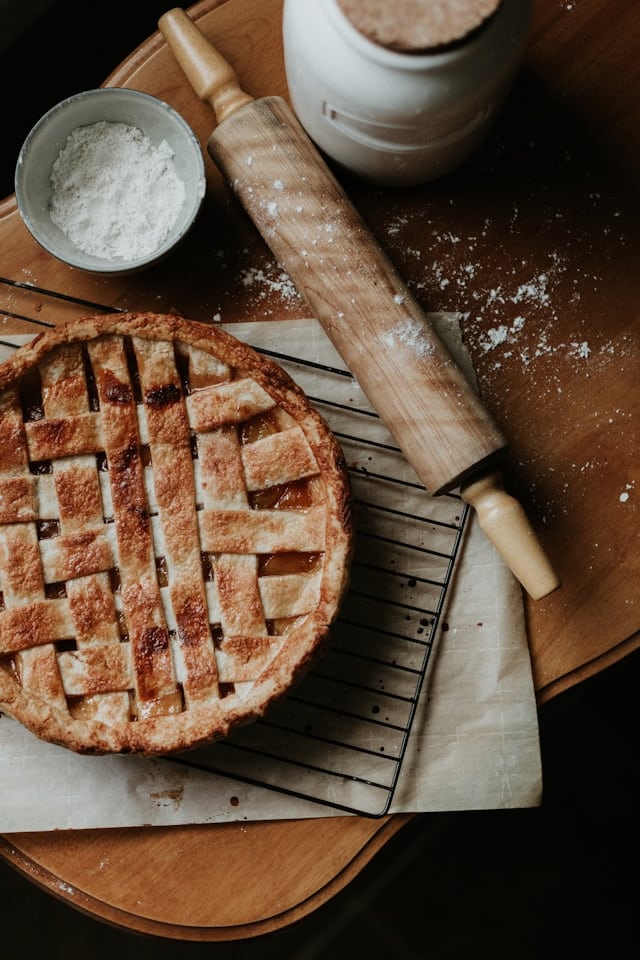What’s the Secret to a Perfectly Crisp French Tarte Tatin with Caramelized Apples?

Are you pining for a succulent, beautifully caramelized apple tarte tatin? If so, you’ve stumbled upon the perfect article. In the following sections, we’ll dive into the secrets of crafting this classic French dessert. Using your standard kitchen equipment— like your trusty skillet and pan— you’ll soon be impressing your family and friends with a pastry masterpiece. Let’s unravel the mystery behind the perfect tarte tatin, one delicious step at a time.
The Importance of Choosing the Right Apples
Before we delve into the intricacies of the tarte tatin recipe, it’s vital to note the significance of selecting the right apples. Not all apples are created equal, especially in the realm of pastry making. Certain varieties can maintain their structure despite being cooked for a long time, while others quickly turn into apple sauce.
A voir aussi : How to Achieve a Creamy and Flavorful Gourmet Mushroom Stroganoff with Fresh Pasta?
Apples like Golden Delicious, Granny Smith, or Braeburn are ideal for a tarte tatin. These types of apples are firm and can withstand the cooking process without falling apart. Plus, they offer a nice balance of tart and sweet flavors, which perfectly complements the rich caramel.
Choosing the right apples isn’t just a matter of taste preference; it’s a crucial step that will determine the success of your tarte tatin. So, take your time to carefully select your apples because they are the star of this show.
Avez-vous vu cela : Can You Master the Art of Authentic Indian Biryani with a Saffron Infused Rice?
The Magic of Caramel
The other half of the tarte tatin’s magic lies in the caramel. The caramelization process transforms a simple apple tart into a tarte tatin. It provides the dessert with its distinctive rich, sweet, and slightly bitter flavor— a perfect counterpoint to the tartness of the apples.
To make the caramel, combine butter and sugar in a skillet over medium heat. Stir continuously for about 10 minutes or until the sugar has completely dissolved and the mixture has taken on a deep amber color. Be patient and resist the temptation to increase the heat; doing so will burn the sugar and give your caramel a bitter taste.
During the caramelization process, the butter and sugar form a beautiful, golden syrup that envelops the apples, giving them a glossy, appetizing finish. Essentially, the caramel acts as a flavor enhancer, taking your tarte tatin from good to great.
Preparing the Perfect Pastry Dough
A great tarte tatin recipe wouldn’t be complete without a flaky, buttery pastry to contrast with the caramelized apples. This is where the puff pastry comes in. Now, while you can certainly buy pre-made puff pastry, making your own from scratch will give your tart a more authentic and personal touch.
To make puff pastry, you’ll need time, patience, and a bit of skill. However, the result— a light, crispy, and buttery pastry— is undeniably worth the effort. The key to a great puff pastry lies in creating hundreds of thin layers of dough and butter. When baked, the water in the butter evaporates, causing the dough to rise and create the puff pastry’s characteristic flaky texture.
Combining the Ingredients and Baking the Tarte Tatin
After preparing the apples, caramel, and pastry, it’s time to assemble and bake the tarte tatin. First, arrange the caramelized apples at the bottom of your pan. Then, top the apples with the puff pastry, tucking in the edges around the apples.
Bake the pie in your pre-heated oven for about 25 minutes, or until the pastry is golden and crisp. One of the unique aspects of a tarte tatin is that it is baked upside-down. After removing it from the oven, you will need to carefully flip it onto a serving plate so that the caramelized apples are on top.
The baking process is the final step in creating your masterpiece. The heat from the oven will further caramelize the apples, giving them a deeper flavor and color, and crisp up the pastry, making it a perfect contrast to the soft, caramelized apples.
The Tarte Tatin: A Truly French Delight
The tarte tatin is more than just an apple pie; it’s a testament to the beauty of French cuisine. With its caramelized apples and flaky pastry, this dessert captures the essence of French culinary tradition in every bite. And though it may require a bit of effort and time, the result is well worth it— a deliciously sweet and tart dessert that will have your guests asking for more.
Creating the perfect tarte tatin may seem daunting at first, but with the correct apples, a beautifully caramelized sugar and butter mixture, and a crisp, golden puff pastry, you’re well on your way to crafting this French classic. So, put on your apron, preheat your oven, and get ready to experience one of the finest treats French cuisine has to offer. Your tarte tatin adventure begins now.
The Role of Apple Cider and Lemon Juice in Tarte Tatin
When it comes to crafting the perfect tarte tatin, two ingredients often go overlooked: apple cider and lemon juice. These two ingredients play subtle yet important roles in creating the mouthwatering taste and aroma that is characteristic of this French apple tart.
Apple cider enhances the natural sweetness and flavor of the apples. By simmering the apples in apple cider before caramelization, you can infuse them with a deeper, sweeter apple flavor. This step can make a huge difference in the overall taste of your tarte tatin. However, be careful not to overdo it. Too much apple cider can make your apples too sweet, overpowering the tartness that is also essential to a well-balanced tarte tatin.
Lemon juice, on the other hand, serves a dual purpose. First, it prevents the apples from browning during preparation. Second, it adds a hint of acidity which balances out the sweetness of the apples and the caramel. Just a squeeze of lemon juice can bring a bright and refreshing note to your apple tarte, preventing it from becoming overly sweet or cloying.
Serving and Enjoying Your Tarte Tatin
Once your tarte tatin is perfectly baked and beautifully flipped onto a serving plate, it’s time to enjoy the fruits of your labor. One of the best ways to serve tarte tatin is warm, straight from the oven. The heat intensifies the flavors and the aroma of the caramelized apples and the buttery puff pastry, making it irresistibly delicious.
While tarte tatin is undoubtedly delicious on its own, it pairs wonderfully with a scoop of vanilla bean ice cream or a dollop of crème fraîche. The cold creaminess of the ice cream or crème fraîche contrasts beautifully with the warm, sweet, and tart flavors of the tarte, enhancing its overall taste and texture.
When it comes to serving tarte tatin, presentation is also key. The golden caramelized apples on top should be on full display, shining under the light and enticing everyone who lays eyes on it. After all, a tarte tatin is not just a dessert; it’s a showstopper, a masterpiece of French culinary tradition.
Conclusion: The Joy of Baking Tarte Tatin
Baking a tarte tatin may come with its challenges, but the final product—a perfectly crisp, caramelized apple tarte—is worth every bit of effort. From selecting the right Granny Smith apples and crafting a buttery puff pastry, to achieving that deep golden brown caramel, every step contributes to the making of this classic French dessert.
As you bite into your tarte tatin, savoring the crunch of the puff pastry, the sweet and tart flavors of the caramelized apples, and the creamy coolness of the vanilla bean ice cream, you’ll realize that the joy of baking tarte tatin lies not only in the finished product but also in the process itself. It’s a journey of discovery, patience, and skill—a testament to the beauty of baking.
So, gather your ingredients, roll up your sleeves, and embark on your tarte tatin baking adventure. This delectable French apple tart is waiting for you to bring it to life in your kitchen. Good luck, and happy baking!
